Fronius Selectiva 2020E Operating Instructions Manual
- Category
- Battery chargers
- Type
- Operating Instructions Manual
This manual is also suitable for

Operating instructions
Battery charger
42,0426,0040,EN 012006
GB
Selectiva 1020E / 1030E
2010E / 2020E / 2032E / 2035E
Acctiva 1020E / 1030E
10-2020E
2010E


ud_fr_st_et_00493 012004
Dear Reader
Thank you for choosing Fronius - and congratulations on your new, technically high-
grade Fronius product! This instruction manual will help you get to know your new
machine. Read the manual carefully and you will soon be familiar with all the many
great features of your new Fronius product. This really is the best way to get the most
out of all the advantages that your machine has to offer.
Please also take special note of the safety rules - and observe them! In this way, you
will help to ensure more safety at your product location. And of course, if you treat your
product carefully, this definitely helps to prolong its enduring quality and reliability - things
which are both essential prerequisites for getting outstanding results.
Introduction


Iud_fr_ls_sv_01055 022006
Safety rules
WARNING!
CAUTION!
„NOTE!“ indicates a risk of flawed results and possible damage to the
equipment.
NOTE!
The charger is manufactured in line with the latest state of the art and
according to recognised safety standards. If used incorrectly or misused,
however, it can cause
- injury or death to the user or a third party,
- damage to the charger and other material assets belonging to the opera-
tor,
- inefficient operation of the charger.
All persons involved in commissioning, operating, maintaining and servicing
the charger must
- be suitably qualified,
- have knowledge of and experience in dealing with chargers and batteries
and
- read and follow these operating instructions carefully.
The operating instructions must always be at hand wherever the charger is
being used. In addition to the operating instructions, attention must also be
paid to any generally applicable and local regulations regarding accident
prevention and environmental protection.
All safety and danger notices on the charger
- must be kept in a legible state
- must not be damaged/marked
- must not be removed
- must not be covered, pasted or painted over.
For the location of the safety and danger notices on the charger, refer to
„General remarks“ in the charger operating instructions.
Before switching on the charger, remove any faults that could compromise
safety.
Your personal safety is at stake!
General remarks
Important!
„WARNING!“ indicates a possibly dangerous situation. If it is not avoided,
death or serious injury may result.
„CAUTION!“ indicates a situation where damage or injury could occur. If it
is not avoided, minor injury and/or damage to property may result.
„Important!“ indicates tips for correct operation and other particularly useful
information. It does not indicate a potentially damaging or dangerous situati-
on.
If you see any of the symbols depicted in the „Safety rules“, special care is
required.

II
ud_fr_ls_sv_01055 022006
The charger is to be used exclusively for its intended purpose. Utilisation for
any other purpose, or in any other manner, shall be deemed to be „not in
accordance with the intended purpose“. The manufacturer is not liable for
any damage, inadequate or incorrect results arising out of such misuse.
Utilisation in accordance with the “intended purpose” also comprises
- carefully reading and obeying all operating instructions and safety and
danger notices
- performing all stipulated inspection and servicing work.
- following all instructions from the battery and vehicle manufacturers
Utilisation in
accordance with
„intended purpo-
se“
Batteries contain acid which is harmful to the eyes and skin. During charging,
gases and vapours are released that can harm health and are highly explosi-
ve in certain circumstances.
- Possible sources of ignition, such as fire and naked lights, must be kept
away from the battery
- The battery connection (e.g. charging terminals) must not be discon-
nected for any reason during charging
- On no account inhale any of the gases and vapours released
- Make sure the area is well ventilated.
- To prevent short circuits, do not place any tools or conductive metals on
the battery
- Battery acid must not get into the eyes, onto the skin or clothes. Wear
protective goggles and suitable protective clothing. Rinse any acid
splashes thoroughly with clean water, seek medical advice if necessary.
Risks from acid,
gases and va-
pours
Risks from mains
current and
charging current
Anyone working with chargers exposes themselves to numerous risks e.g.:
- risk of electrocution from mains current and charging current
- hazardous electromagnetic fields, which can risk the lives of those using
cardiac pacemakers
An electric shock can be fatal. Every electric shock is potentially life threate-
ning. To avoid electric shocks while using the charger:
- do not touch any live parts inside or on the outside of the charger.
- under no circumstances touch the battery poles
- do not short-circuit the charger lead or charging terminals
All cables and leads must be complete, undamaged, insulated and adequate-
ly dimensioned. Loose connections, scorched, damaged or inadequately
dimensioned cables and leads must be immediately repaired by authorised
personnel.
Operation and/or storage of the charger outside the stipulated area will be
deemed as „not in accordance with the intended purpose.“ The manufacturer
shall not be liable for any damage resulting from such improper use.
For exact information on permitted environmental conditions, please refer to
the „Technical data“ in the operating instructions.
Environmental
conditions

III ud_fr_ls_sv_01055 022006
Protecting
yourself and
others
While the charger is in operation, keep all persons, especially children, out of
the working area. If, however, there are people in the vicinity,
- warn them about all the dangers (hazardous acids and gases, danger
from mains and charging current, etc),
- provide suitable protective equipment.
Before leaving the work area, ensure that no-one or nothing can come to any
harm in your absence.
- Chargers with PE conductors must only be operated on a mains supply
with a PE conductor and a socket with an earth contact. If the charger is
operated on a mains without a PE conductor or in a socket without an
earth contact, this will be deemed to be gross negligence. The manufac-
turer shall not be liable for any damage resulting from such improper use.
- Only operate the charger in accordance with the degree of protection
shown on the rating plate.
- Under no circumstances operate the charger if there is any evidence of
damage.
- Ensure that the cooling air can enter and exit unhindered through the air
ducts on the charger.
- Have the mains and charger supply checked regularly by a qualified
electrician to ensure the PE conductors are functioning properly.
- Any safety devices and components that are not functioning properly or
are in an imperfect condition must be repaired by an qualified technician
before switching on the charger.
- Never bypass or disable protection devices.
Safety measures
in normal mode
It is the operator’s responsibility to ensure that no electromagnetic interfe-
rence occurs in electrical and electronic devices.
Class A chargers can cause radio interference in residential areas. If this
happens, the operator may be required to take appropriate measures.
EMC and EMF
measures
The user is responsible for the safekeeping of any changes made to the
factory settings. The manufacturer accepts no liability for any deleted perso-
nal settings.
Data protection
General informa-
tion regarding
the handling of
batteries
- Protect batteries from dirt and mechanical damage.
- Store charged batteries in a cool place. Self-discharge is kept to a mini-
mum at approx. +2° C (35.6° F).
- Every week, perform a visual check to ensure that the acid (electrolyte)
level in the battery is at the Max. mark.
- If any of the following occurs, do not start the machine (or stop immedia-
tely if already in use) and have the battery checked by an authorised
workshop:
- uneven acid levels and/or high water consumption in individual cells
caused by a possible fault.
- overheating of the battery (over 55° C/131° F).
Under normal operating conditions the charger requires only a minimum of
care and maintenance. However, it is vital to observe some important points
to ensure it remains in a usable condition for many years.
- Before switching on, always check the mains plug and cable, and char-
ger leads/charging terminals for any signs of damage.
Maintenance and
repair

IV
ud_fr_ls_sv_01055 022006
- If the surface of the charger housing is dirty, clean with a soft cloth and
solvent-free cleaning agent only
Maintenance and repair work must only be carried out by authorised person-
nel. Use only original replacement and wearing parts (also applies to stan-
dard parts). It is impossible to guarantee that bought-in parts are designed
and manufactured to meet the demands made on them, or that they satisfy
safety requirements.
Do not carry out any modifications, alterations, etc. without the
manufacturer’s consent.
Dispose of in accordance with the applicable national and local regulations.
The warranty period for the charger is 2 years from the date of invoice.
However, the manufacturer will not accept any liability if the damage was
caused by one or more of the following:
- Use of the charger „not in accordance with the intended purpose“
- Improper installation and operation
- Operating the charger with faulty protection devices
- Non-compliance with the operating instructions
- Unauthorised modifications to the charger
- Catastrophes caused by the activities of third parties and force majeure
Guarantee and
liability
Do not dispose of this device with normal domestic waste!
To comply with the European Directive 2002/96/EC on Waste Electrical and
Electronic Equipment and its implementation as national law, electrical
equipment that has reached the end of its life must be collected separately
and returned to an approved recycling facility Any device that you no longer
require must be returned to our agent, or find out about the approved collec-
tion and recycling facilities in your area.
Ignoring this European Directive may have potentially adverse affects on the
environment and your health!
Disposal
Maintenance and
repair
(continued)
The operator is obliged to arrange a safety inspection of the device at least
once every 12 months.
The manufacturer recommends that the power source is calibrated during
the same 12 month period.
A safety inspection must be carried out by a qualified electrician
- after any changes are made
- after any additional parts are installed and after any conversions
- after repair, care and maintenance
- at least every twelve months.
For safety inspections, follow the appropriate national and international
standards and directives.
Further information on safety inspections and calibration is available from
your service centre, who will be happy to provide you with the required
documentation.
Safety inspection

Vud_fr_ls_sv_01055 022006
Copyright of these operating instructions remains with the manufacturer.
Text and illustrations were accurate at the time of printing. Subject to change
without notice. The content of the operating instructions does not justify any
claims that may be made by the purchaser. We are grateful for any suggesti-
ons for improvement and for drawing our attention to any errors in these
instructions.
Copyright
Chargers with the EC marking satisfy the fundamental requirements of the
low-voltage and electromagnetic compatibility directive.
Safety
Devices with the TÜV test mark satisfy the requirements of the relevant
standards in Canada and USA.
Devices with the TÜV test mark satisfy the requirements of the relevant
standards in Japan.
Devices displaying this TÜV test mark and the mark on the rating plate
satisfy the requirements of the relevant standards in Australia.

VI
ud_fr_ls_sv_01055 022006

1
Table of contents
General remarks ........................................................................................................................................... 2
Basic system principle.............................................................................................................................. 2
Charger concept ...................................................................................................................................... 2
Warning notices affixed to the charger..................................................................................................... 2
Before commissioning ................................................................................................................................... 3
Safety ....................................................................................................................................................... 3
Utilisation in accordance with „intended purpose“ .................................................................................... 3
Mains connection ..................................................................................................................................... 3
Safety strategy - standard protective features.......................................................................................... 4
Controls and connections .............................................................................................................................. 4
General remarks ...................................................................................................................................... 4
Control panel ............................................................................................................................................ 4
Plugging in options ................................................................................................................................... 5
Connections on housing underside .......................................................................................................... 5
Connections on top of housing................................................................................................................. 5
Removing cover ....................................................................................................................................... 6
Installation ................................................................................................................................................ 6
Fitting relay (optional) ............................................................................................................................... 7
Charging the battery ...................................................................................................................................... 7
Starting charging ...................................................................................................................................... 7
Charging................................................................................................................................................... 8
Finishing charging .................................................................................................................................... 8
Interrupting charging ..................................................................................................................................... 8
Stopping charging .................................................................................................................................... 8
Restarting charging .................................................................................................................................. 9
Setup menu ................................................................................................................................................... 9
General remarks ...................................................................................................................................... 9
Opening the setup menu .......................................................................................................................... 9
Selecting characteristic type .................................................................................................................. 10
Back-up mode (Acctiva series only) .............................................................................................................11
Explanation .............................................................................................................................................11
Access .................................................................................................................................................... 11
Back-up mode .........................................................................................................................................11
Stopping back-up mode ......................................................................................................................... 12
Trickle charging (Acctiva series only) .......................................................................................................... 12
Explanation ............................................................................................................................................ 12
Reactivating a deep-discharge battery (Acctiva series only) ....................................................................... 12
Explanation ............................................................................................................................................ 12
Troubleshooting........................................................................................................................................... 13
Safety ..................................................................................................................................................... 13
Activation of protective features ............................................................................................................. 13
Charging errors ...................................................................................................................................... 14
Technical data ............................................................................................................................................. 14
Explanation ............................................................................................................................................ 14
Fronius Worldwide

2
General remarks
The main feature of the new Active Inver-
ter Technology is „intelligent charging“.
This means that the charging behaviour
adapts itself automatically to the age and
charge level of the battery. This innovation
improves the battery’s service life and low
maintenance properties, not to mention
the user’s pocket!
Active Inverter Technology is based on an
inverter with active rectification and an
intelligent safety cut-out. The charging
current and voltage are held constant by a
digital control that is not affected by any
fluctuations in the mains voltage.
Basic system
principle
The compact design reduces space requirements and makes portable use considerably
easier. Add to this the fact that the active inverters can be used „on-board“. In addition to
its many existing features, the charger is also of modular design, making it perfectly
capable of accommodating future requirements. A wide range of options is available.
Charger concept
Fig. 1 Charger: Selectiva Active Inverter
A number of safety symbols can be seen on the charger’s rating plate. The safety
symbols must NOT be removed or painted over.
Warning notices
affixed to the
charger
Fig. 2 Rating plate
Do not use the functions until you have fully read all the operating instructions.
Possible sources of ignition, such as fire, sparks and naked lights, must be kept away from the
battery.
Risk of explosion! Detonating gas is generated in the battery during charging.
Battery acid is corrosive and MUST be kept away from eyes, skin and clothes.
For indoor use only. Do not expose to rain.
Do not dispose of used chargers with domestic waste. Dispose of them according to safety
regulations.
Ensure an adequate supply of fresh air during charging. Fit charger at least 50 cm above the
floor.

3
Before commissioning
WARNING! Operating the equipment incorrectly can cause serious injury and
damage. You should not use the functions described until you have thoroughly
read and understood the following documents:
- Operating instructions
- All the operating instructions for the system components, especially the
safety regulations
- Battery and vehicle manufacturers’ operating and safety instructions
Mains connection The rating plate, which is located on the housing, contains information about the permit-
ted mains voltage. The charger is designed for this mains voltage only. The required fuse
protection for the supply can be found in the accompanying characteristic data sheet. If
there is no network cable or mains plug on your charger, fit a network cable or plug
according to the national standards.
NOTE! Inadequately dimensioned electrical installations can lead to serious
damage. The mains lead, and its fuse protection, must be dimensioned in
accordance with the local power supply. The technical data shown on the rating
plate shall apply.
The charger is only for charging batteries as detailed in the accompanying characteristic
data sheet. Any other form of usage is deemed „not in accordance with the intended
purpose“. The manufacturer shall not be liable for any damage resulting from such
improper use. Utilisation in accordance with the „intended purpose“ also comprises
- Following all the instructions in this manual
- Regular checking of mains and charger cables
Utilisation in
accordance with
„intended purpo-
se“
WARNING! Charging dry batteries (primary cells) and non-rechargeable
batteries can cause serious injury or damage, and is therefore prohibited.
Safety

4
WARNING! Operating the equipment incorrectly can cause serious injury and
damage. You should not use the functions described until you have thoroughly
read and understood the following documents:
- These operating instructions
- All operating instructions for the system components, especially the
„Safety rules“
NOTE! As a result of firmware updates, you may find that there are functions
available on your charger that are not described in these operating instructions
or vice versa. Certain illustrations may also differ slightly from the actual cont-
rols on your unit. However, the functionality of these controls is identical.
No. Function - Standard version
(1) Charge level indicator 25%
(2) Charge level indicator 50%
(3) Charge level indicator 75%
Fig .3 Control panel
Important! The control panel (LED version) is explained below.
(1)
(2)
(3)
(4)
No. Function - Switching version
(1) Charge level indicator 25%
(2) Charge level indicator 50%
(3) Charge level indicator 75%
(7)
(5)
(6)
(8)
Standard version Switching version
The new chargers are not just characterised by purely functional features. In terms of
safety, the active inverters are also equipped to the highest standards. The following
safety features come as standard:
- Voltage-free and spark-free terminals protect against explosions
- Reverse polarity protection prevents the battery or charger from being damaged or
destroyed
- Short-circuit protection provides effective protection for the charger. The fuse does
not need to be replaced in the event of a short circuit.
- A charging time monitor provides effective protection against overcharging and
destruction of the battery
- Thanks to the high level of protection, there is a lower rate of contamination in
adverse conditions. This adds to the charger’s reliability.
- Overtemperature protection through derating (charging current reduced if the
temperature rises above the permitted level)
Safety strategy -
standard protec-
tive features
Controls and connections
General remarks
Control panel

5
(4) Charge level indicator 100%
(5) Ready indicator
(6) -
(7) Start/stop and setup button
- For interrupting and restarting char-
ging
- For accessing the setup menu and
selecting the characteristic type
(press and hold for 10 s)
(8) Error indicator
(4) Charge level indicator100%
(5) Ready indicator, charging voltage
12 V
(6) Ready indicator, charging voltage
24 V
(7) Start/stop, voltage selection and
setup button
- For interrupting and restarting char-
ging
- For selecting charging voltage 12 V /
24 V
- For accessing the setup menu and
selecting the characteristic type
(press and hold for 10 s)
(8) Error indicator
Standard control
panel
(continued)
Fig. 5 Top of housing
Fig. 4 Bottom of housing
No. Function
(9) AC Input - mains socket
(10) Mains cable safety catch
holds in place
(11) P2 - I/O port interface
for options on the I/O port
(12) P1 interface - charging cable
socket
also for external stop and temperatu-
re-controlled charging options
No. Function
(13) Connection cable
(14) Removable display
(15) P3 interface - visual port
for connecting an internal or external
display
(16) P4 interface - multiport
for connecting status lamp, data
communications, etc.
(9) (11) (12)
Connections on
top of housing
(14) (15) (16)
(10)
(13)
Plugging in
options
NOTE! Risk of damage to charger and accessories. Only plug in options and
system add-ons when the mains plug is unplugged and the charging cables are
disconnected from the battery.
Connections on
bottom of hou-
sing

6
If installing the charger on a firm base, use drilling template enclosed in the packaging.
NOTE! Protection IP44 is only guaranteed for the upright position.
If the charger is installed in a switch cabinet (or similar separate area), then
forced-air ventilation must be provided to ensure adequate heat dissipation.
There should be a gap of 10 cm (3.94 in.) all around the charger.
The space requirement measurements in mm (inches) illustrated below are given to
ensure that there is easy access to the plug connections:
Fig. 7 Space requirements
140
(5.51)
233 (9.17)
247 (9.72)
88 (3.46)
6,5 (.26)
Fig. 6 Removing display and covers
If necessary, use a screwdriver to remove:
- Display (14)
- P3 visual port connection cover (17)
- P4 multiport connection cover (18)
- P2 I/O port connection cover (19)
(17)
(14) (18)
Removing the
cover
Installation
11
70
(2.76)
20 (.79)
221 (8.7)
5 (0.2)
(19)

7
1
2
3
4
Important! The torque for all screws is 2.5
Nm.
1. Remove three screws (21)
2. Fit bracket (22) using the previously
removed screws (21)
3. Remove screw (21)
4. Fit charging plug strain relief device
(23) using the previously removed
screw (21)
Fitting the bra-
cket (option)
Fig. 8 Fitting the bracket and strain relief
device
1. Connect mains cable to charger and connect to mains
2. Charger in open circuit - ready indicator lights up:
CAUTION! Risk of damage when attempting to charge a faulty battery, or if
using the incorrect charging voltage. Before beginning charging, ensure that
the battery to be charged is fully functional and the charging voltage of the
charger matches the battery voltage.
3. On the switching version, select the battery voltage using the Start/Stop button
4. Select characteristic type according to the battery to be charged
Important! Information on which characteristic type to select can be found in the section
„The Setup menu“ or the enclosed characteristic data sheet.
Charging the battery
Starting charging
5. If using the vehicle power supply, switch off ignition and all other loads
6. Connect charging cable (red) to positive pole (+) on battery
7. Connect charging cable (black) to negative pole (-) on battery
WARNING! Risk of serious injury or damage from incorrectly connected
charging terminals. Connect charging terminals to correct poles and ensure
proper electrical connection to battery terminals.
12 V
24 V
SwitchingStandard
(21) (21) (23)
(22)

8
10. Press Start/Stop button to complete charging
11. Disconnect charging cable (black) from negative pole (-) on battery
12. Disconnect charging cable (red) from positive pole (+) on battery
CAUTION! Risk of sparks if the charging terminals are disconnected too
soon. Press Start/Stop button to finish charging
1. Press Start/Stop button to stop charging
2. Charging stopped - operating indicator flashes
Note! Risk of damage to connection sockets and plugs. Do not disconnect or
unplug the charging cable while charging.
Finishing char-
ging
Interrupting charging
Stopping char-
ging
SwitchingStandard
12 V
24 V
9. Conservation charging: Once the battery is fully charged, the charger automatically
switches to conservation charging to prevent battery self-discharge. The battery can
remain connected to the charger for any length of time.
7. Charging begins automatically after approx. 2 seconds
8. A set of four LEDs show the battery’s charge level
25 % 50 % 75 % 100 %
Charging

9
Important! The following section only applies to the standard control panel (LED version).
In the setup menu, select the characteristic type according to the battery to be charged,
or the requirement shown in the accompanying characteristic data sheet (normal char-
ging, backup mode, reactivating deep-discharge batteries, trickle charging).
Important! Do not connect the charging cable to the battery. If the charging terminals
are connected, no characteristic type can be selected.
1. Connect mains cable to charger and plug into mains
2. Charger in open circuit - ready indicator lights up
3. Press and hold Start/Stop button for approx. 10 secs to call up the setup menu
approx. 10 secs
4. Ready indicator lights goes out
The charger is in setup mode
The display also shows the selected characteristic type
12 V
24 V
SwitchingStandard
12 V
24 V
SwitchingStandard
3. Press Start/Stop button to continue chargingRestarting char-
ging
Setup menu
General remarks
Opening the
setup menu

10
5. Press Start/Stop button to select the characteristic type according to the enclosed
characteristic data sheet
6. If there is no further selection within 10 seconds, the selected characteristic type is
saved.
Important! Do not connect a battery during these 10 seconds.
Continue as described in the section „Charging the battery“.
7. Ready indicator lights up. Once the new characteristic type has been selected, the
charger is automatically ready for the next charging sequence:
Selecting the
characteristic
type
12 V
24 V
SwitchingStandard
Page is loading ...
Page is loading ...
Page is loading ...
Page is loading ...
Page is loading ...
Page is loading ...
Page is loading ...
Page is loading ...
-
 1
1
-
 2
2
-
 3
3
-
 4
4
-
 5
5
-
 6
6
-
 7
7
-
 8
8
-
 9
9
-
 10
10
-
 11
11
-
 12
12
-
 13
13
-
 14
14
-
 15
15
-
 16
16
-
 17
17
-
 18
18
-
 19
19
-
 20
20
-
 21
21
-
 22
22
-
 23
23
-
 24
24
-
 25
25
-
 26
26
-
 27
27
-
 28
28
Fronius Selectiva 2020E Operating Instructions Manual
- Category
- Battery chargers
- Type
- Operating Instructions Manual
- This manual is also suitable for
Ask a question and I''ll find the answer in the document
Finding information in a document is now easier with AI
Related papers
-
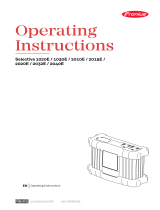 Fronius 1020E Selectiva BATTERY CHARGERS Operating instructions
Fronius 1020E Selectiva BATTERY CHARGERS Operating instructions
-
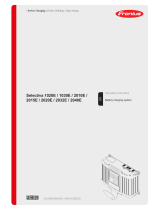 Fronius Selectiva 2040E Operating Instructions Manual
Fronius Selectiva 2040E Operating Instructions Manual
-
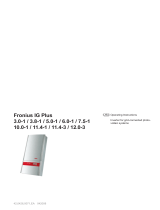 Fronius IG Plus A 3.8-1 UNI Operating Instructions Manual
Fronius IG Plus A 3.8-1 UNI Operating Instructions Manual
-
Fronius Energy Package User manual
-
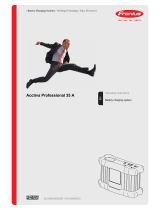 Fronius Acctiva Professional 35 A User manual
Fronius Acctiva Professional 35 A User manual
-
Fronius Selectiva 4035 2kW Operating Instructions Manual
-
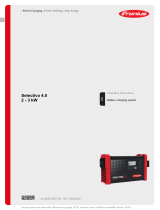 Fronius Selectiva 4.0 4035 Operating Instructions Manual
Fronius Selectiva 4.0 4035 Operating Instructions Manual
-
Fronius 42 User manual
-
Fronius TS 65A-3 User guide
-
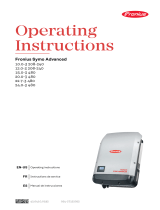 Fronius 24.0-3 480 Symo Advanced Owner's manual
Fronius 24.0-3 480 Symo Advanced Owner's manual
Other documents
-
Jungheinrich SLH 200 Operating instructions
-
Elektron HS 12/24-120-20M Owner's manual
-
Elektron HS12/24-120B Owner's manual
-
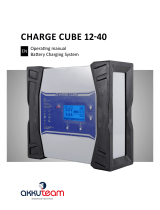 akkuteam CHARGE CUBE 12-40 Operating instructions
akkuteam CHARGE CUBE 12-40 Operating instructions
-
Victron energy ESS (Energy Storage System) Owner's manual
-
Victron energy Energy Storage System Owner's manual
-
Victron energy EasySolar-II GX Owner's manual
-
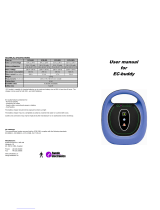 Swede Electronics ECB-1001 User manual
Swede Electronics ECB-1001 User manual
-
Votronic Pb 1215 SMT 2B Operating instructions
-
Telair TBC3i PRO 30-20-250 Carica batterie triplo User manual



































